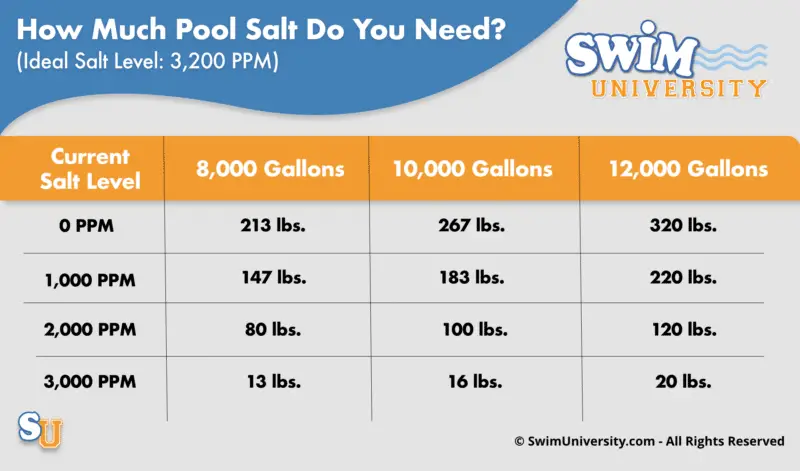To determine how much salt to add to your pool, you should follow the recommended salt level specified by the manufacturer or pool professional. Maintaining the proper salt level is crucial for the effective operation of saltwater pools.
Salt levels are typically measured in parts per million (ppm), with the ideal range being between 2700 ppm and 3400 ppm. Adding too little salt may result in ineffective chlorination, while excessive salt levels can lead to corrosion and damage to pool equipment.
It is important to regularly test the salt levels and adjust accordingly to ensure a well-balanced pool environment.

Credit: 1poolcare.com.au
Importance Of Salt In Pool Maintenance
Maintaining the right salt level in your pool is crucial for efficient pool maintenance. Adding the correct amount of salt ensures optimal water balance and enhances the effectiveness of your sanitizer, promoting a clean and enjoyable swimming experience.
Role Of Salt In Pool Water
Salt in pool water serves as a crucial component for maintaining the balance and sanitation of the pool. It acts as a natural sanitizer and helps to regulate the pH levels, preventing the growth of algae and bacteria. This leads to cleaner and safer water, which enhances the overall swimming experience.
Benefits Of Adding Salt To The Pool
Adding salt to the pool offers several benefits. It provides a more gentle and natural alternative to traditional chlorine, resulting in smoother and softer water that is gentler on the skin and eyes. Additionally, the use of salt can reduce maintenance costs by eliminating the need for frequent chemical adjustments, thus saving time and effort in the long run.
Determining The Right Amount Of Salt
Determining the right amount of salt to add to your pool is essential for maintaining optimal water balance and ensuring a refreshing swimming experience. Let’s explore the factors that influence salt levels and the techniques for measuring salt accurately.
Factors Affecting Salt Levels
Several factors can impact the salt levels in your pool, including evaporation, splash-out, backwashing, and dilution from rainfall. Additionally, temperature fluctuations and bather load can also affect salt concentration. Monitoring these factors regularly can help you maintain the ideal salt level for your pool.
Salt Measurement Techniques
Accurately measuring the salt levels in your pool is crucial for preventing potential issues and ensuring the effectiveness of your saltwater system. There are various methods for measuring salt, including test strips, liquid test kits, and electronic salt testers. Each method has its own benefits, and using a combination of techniques can provide greater accuracy in determining the salt concentration in your pool.
Calculating Salt Quantity For Your Pool
Using Pool Size And Manufacturer Recommendations
Determine pool size in gallons. Check manufacturer guidelines for recommended salt levels.
Online Calculators For A Precise Measurement
Utilize online calculators for accurate salt quantity. Input pool size and current salt levels.
Adding Salt To The Pool
When it comes to maintaining a clean and sparkling swimming pool, adding the right amount of salt is crucial. Salt not only enhances the swimming experience by making the water soft and gentle on the skin, but it also acts as a natural sanitizer, effectively eliminating harmful bacteria and algae.
Manual Addition Methods
If you prefer a more hands-on approach, there are manual methods for adding salt to your pool. One option is to sprinkle the salt directly into the pool water while walking around the perimeter. This can be a bit time-consuming, especially for larger pools, but it ensures even distribution of salt throughout the water.
Alternatively, you can dissolve the salt in a bucket of water and then pour the solution into the pool. This method allows for better control over the amount of salt being added and prevents any undissolved granules from settling at the bottom of the pool. Simply stir the saltwater solution until the salt has fully dissolved, and then pour it into the pool water.
Using Salt Chlorinators For Convenience
If you’re looking for a more convenient and automated solution, salt chlorinators are a great option. These devices are designed to generate chlorine from the salt added to the pool, eliminating the need for traditional chlorine tablets or liquid.
Salt chlorinators have a built-in cell that converts salt into chlorine through the process of electrolysis. This chlorine is then dispersed into the pool water, effectively sanitizing it. The best part is that salt chlorinators continuously generate chlorine, so you don’t have to worry about manually adding it or maintaining chlorine levels.
When using a salt chlorinator, it’s important to periodically check and adjust the salt levels in your pool. The ideal salt level typically ranges between 2700 to 3400 ppm (parts per million). You can use a salt test kit to determine the current salt level and make any necessary adjustments.
In conclusion, adding salt to your pool is a crucial step in maintaining clean and healthy water. Whether you choose to manually sprinkle salt or opt for the convenience of a salt chlorinator, ensuring the proper salt levels will help you enjoy a refreshing swim all season long.
Maintaining Optimal Salt Levels
How to maintain salt water pond? One crucial aspect of pool maintenance is maintaining the optimal salt levels. Too little salt can lead to ineffective chlorine production, while excessive salt can result in corrosion or even damage to pool equipment. Achieving the right balance ensures a clean and safe swimming environment for you and your family. In this section, we will explore the importance of regular testing and adjustment, as well as some valuable tips to prevent salt imbalances.
Regular Testing And Adjustment
Regular testing of your pool’s salt levels is key to maintaining optimal levels. Using a reliable salt test kit or a digital salt meter, you can accurately measure the salt concentration in your pool water. It is recommended to test the water at least once a week, especially during periods of heavy pool usage or extreme weather conditions.
Once you have obtained the salt reading, compare it to the recommended range specified by the manufacturer of your saltwater chlorinator system. This range typically falls between 2500-4000 parts per million (ppm). If the salt concentration is below the recommended range, you will need to add salt to the pool.
Tips: If your salt level is too low, it is better to add small amounts of salt gradually rather than adding a large quantity all at once. This will help prevent overshooting your target salt concentration.
On the other hand, if the salt concentration is higher than the recommended range, you can dilute the pool water by adding fresh water. However, keep in mind that this may also dilute other chemical levels, so it’s crucial to retest and adjust other parameters like pH and alkalinity accordingly.
Tips For Preventing Salt Imbalance
To ensure your pool maintains optimal salt levels, consider following these helpful tips:
- Regularly clean your salt cell or electrode to prevent scale buildup, which can interfere with chlorine production and lead to inaccurate salt readings.
- Keep an eye on your pool’s water balance by regularly testing and adjusting pH and alkalinity levels. Imbalanced pH or alkalinity can affect the efficiency of your salt chlorinator.
- Monitor your pool’s salt level during periods of heavy rainfall or when adding large amounts of fresh water to the pool, as these factors can dilute the salt concentration.
- Consider using a salt chlorinator with a built-in salt level indicator or automation system. These devices can monitor and automatically adjust the salt levels, making maintenance tasks more convenient.
- If you’re unsure about maintaining the salt levels yourself, seek guidance from a pool professional who can assist you in keeping your pool water in optimal condition.
By regularly testing and adjusting your pool’s salt levels and following these preventive tips, you can ensure a well-balanced and properly functioning saltwater pool. Proper maintenance will provide you with crystal-clear water for enjoyable swimming experiences all summer long!

Credit: www.wikihow.com
Dealing With High Salt Levels
Excessive salt in your pool can lead to negative consequences that impact both the water quality and the equipment. Understanding the effects of too much salt, as well as how to safely lower salt levels, is crucial for maintaining a balanced pool environment.
Effects Of Excessive Salt
- Skin and eye irritation
- Corrosion of pool equipment
- Unpleasant taste of pool water
- Reduced effectiveness of chlorine
Lowering Salt Levels Safely
- Drain and dilute pool water
- Use a reverse osmosis system
- Consult a professional for guidance
Effects Of Low Salt Levels
Low salt levels in your pool can have various effects on water quality and the proper functioning of your pool equipment. It’s important to understand the symptoms of low salt levels, as well as the correct method for raising salt levels to maintain a healthy and balanced pool environment.
Symptoms Of Low Salt
When salt levels in your pool are too low, it can lead to a range of symptoms that indicate an imbalance in the water chemistry. These symptoms may include:
- Poor chlorine production
- Algae growth
- Cloudy water
- Increased corrosion of pool equipment
Raising Salt Levels Correctly
To address low salt levels and alleviate the associated symptoms, it’s essential to raise salt levels correctly. This process involves:
- Testing the current salt level using a reliable salt testing kit
- Adding salt in increments according to the manufacturer’s recommendations
- Allowing the salt to dissolve thoroughly before retesting and making further adjustments
Expert Tips For Salt Maintenance
Seasonal Adjustments
Making seasonal adjustments to the salt levels in your pool is vital for ensuring its proper maintenance and functionality. During the summer months, when evaporation rates are higher, it’s recommended to increase the salt level by 500 ppm to compensate for the loss. Conversely, in the winter, when the pool isn’t being used as frequently, a slight decrease in salt levels may be required. Regularly testing and adjusting the salt levels based on the season can help maintain a balanced and efficient pool.
Common Mistakes To Avoid
One common mistake pool owners make is adding too much salt at once, which can lead to over-salting and potential damage to pool components. Another mistake is neglecting to regularly test the salt levels, which can result in inefficient chlorine production and potential algae growth. Additionally, failing to properly clean the salt cell can lead to decreased performance and increased maintenance costs. It’s essential to follow manufacturer guidelines and conduct routine maintenance to avoid these common pitfalls.

Credit: poolwatermedic.com
Conclusion
Maintaining proper salt levels in your pool is crucial for clean and balanced water. Remember, too little salt can affect chlorine production. Always test regularly and follow manufacturer guidelines for adding salt to your pool. Keep your pool in optimal condition by ensuring the right amount of salt is maintained.





